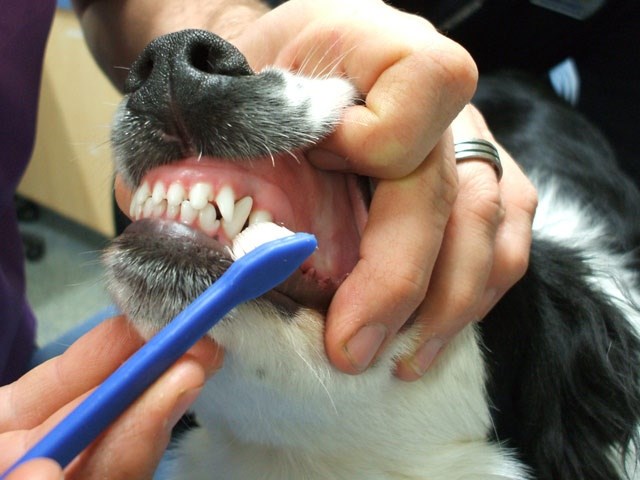How to Brush Your Pet's Teeth
Since February is our dental health awareness month, this blog focuses on the #1 method to take care of your pet's oral health at home - brushing their teeth!
When should I start brushing my puppy's or kitten's teeth?
Brushing your puppy's or kitten's teeth is a fantastic way to get them used to the habit and get them used to you having their hands inside their mouth. (This second benefit comes into play when they bite or grab something they shouldn't and you need to get it out of their mouth without them biting you!) Brushing your puppy's or kitten's teeth early on in their life (around 3-4 months old) sets them up for excellent oral health habits when they are older. After all, when they are a baby everything is new and exciting! Brushing their teeth can be one of those exciting moments for you and your pet to bond! Most puppy and kitten deciduous (baby) teeth fall out around 5-6 months of age, as the adult teeth are growing in. Once the adult teeth are in, those teeth are permanent so brushing them on a regular basis becomes very important!
What do I use to brush my pet's teeth?
There are many options out there for the toothbrush! You can use a pet toothbrush, child or baby toothbrush, finger brush, or even a gauze or soft cloth. Be sure to find one that fit's your pet's mouth (ie smaller brush head for a smaller dog or cat, or a larger brush head for a large breed dog)
In terms of toothpaste, please only use pet toothpaste. Pet toothpaste comes in a variety of flavours that dogs and cats enjoy including chicken, beef, and malt. Human toothpaste products are NOT safe for pets.
How do I brush their teeth?
(1) Try finding a time when you are both relaxed and spending time together on the couch. If it is your first time brushing, it is easier to do it when your pet is more relaxed at the end of the day. Having a couple of their favourite treats on hand as well helps make it a positive experience.
(2) Give your pet a tiny taste of the toothpaste. Since most pet toothpastes are flavoured to suit dogs and cats, most of them like the taste.
(3) Put a small amount of toothpaste on your brush (toothbrush, fingerbrush, or cloth/gauze).
(4) Lift the lip to expose the outer surface of the teeth. Remember there are teeth in the back of the mouth too!
(5) Brush the outer surfaces gently, giving your pet praise and taking breaks as needed. *Note* - You don't have to brush the inside of the teeth (where the tongue is or the roof of the mouth) - animals don't tend to get as much plaque and tartar build up on those surfaces!
(6) The number one spot we see tartar build up is on the upper molars. These teeth lay behind their cheeks. Remember to brush back there too!
(7) Gently moved the brush around to the various spots in the mouth. There are the incisors (the front teeth that make the smile), the canines (the "fangs"), and the premolars and molars (on the sides of their mouth, behind their cheeks).
(8) Last, but not least, REWARD your pet with their favourite treat, activity, or a good cuddle! They did an excellent job!
Check out this Youtube video with a full demonstration:
https://www.youtube.com/watch?v=PsNlLLSBWLU
Tips:
Sometimes your pet won't let you brush their whole mouth at once. That's okay, you can do one part at a time and split it up over a few days.
If your pet resents brushing a certain part of their mouth regularly please bring them in for a dental assessment. There could be an infected or broken tooth that is causing them pain. Dental Assessments are no charge during our dental health awareness month!

How often do I brush my pet's teeth?
Ideally, you should brush your pet's teeth every day, just like you brush your own teeth. Realistically, if you can do it a couple times a week that is fantastic!
How do I know if my pet's teeth need to be professionally cleaned?
If the tartar is very thick, the teeth are discoloured, or you notice a smell coming from your pet's mouth (that's from all the bacteria on their teeth!), your pet would benefit from a professional dental scale and polish. If teeth are wiggly or your pet appears in pain when their teeth are touched, those teth may need to be extracted too. This process is very similar to what your dentist and dental hygienist do for you. Some pets, especially small breed dogs, greatly benefit from a dental scale and polish every 1-2 years. This is because their mouths are so small there is not as much room for saliva to circulate, which results in food particles sitting on the teeth for prolonged periods of time. This causes significant build up of plaque and tartar.
What if my pet doesn't let me brush their teeth?
Stay tuned for next week's blog on the other dental home care options for dogs and cats!